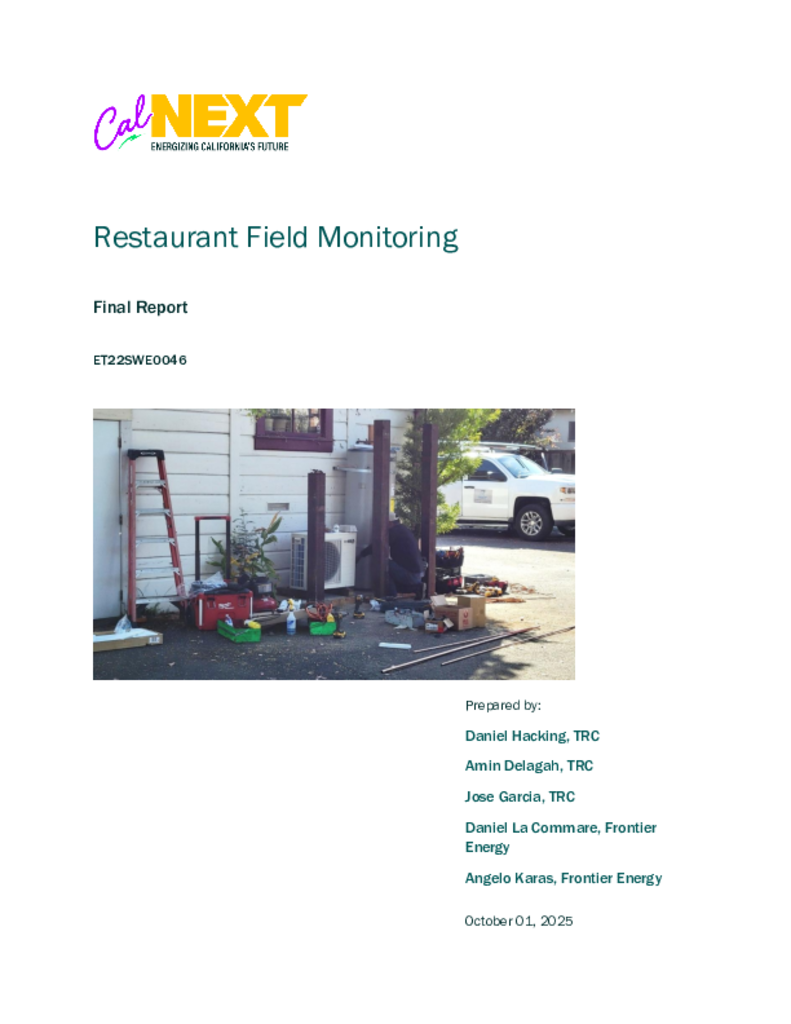ET22SWE0046 - Restaurant Field Monitoring
This field demonstration project in a full food service facilities, starting from large quick service restaurants or larger restaurant involves pre-retrofit energy monitoring of existing domestic hot water systems, the installation of single-pass air-source heat pumps (HPs) and other efficiency measures, and post-monitoring of optimized systems. Hot water is primarily used for sanitation purposes in commercial kitchens. A 2013 study (CEC-500-2013-050) by Fisher-Nickel Inc. estimated gas-load for domestic hot water (DHW) in foodservice at 340 million therms per year across 85,500 facilities. This project intends to demonstrate the energy savings potential from shifting the primary hot water energy load from the existing gas-fired or electric resistance heaters to high-efficiency HPs. Load flexibility measures via controls will be utilized to operate only at off-peak periods between 9pm to 4pm to minimize restaurant operating cost and maximize grid benefits to California if feasible and advantageous to the site selected. Any potential operating cost increase from switching from primary gas heating to electric in a restaurant will be offset with sensible efficiency measures on the distribution system (e.g., addition of master mixing valves) and end-use equipment (e.g. heat recovery dishmachine) where feasible and in a manner accepted by the site owner as to not negatively impact operations. If possible, we will try to perform additional testing to isolate the energy savings impact of heat-recovery dishmachine and the master mixing valve.
This proposed HP retrofit ‘add-on' project will, by design, keep the existing water heater in place to serve a much lower heat load and serve as a backup, so as not to trigger health department review. Positioning this project as a retrofit add-on versus replacement or new build application has other benefits as well, since it removes a lot of risk associated with design, operation, maintenance, and operating cost. The HP and storage tank do not have to be sized to meet the winter design day load and handle the high variability in daily hot water use in this segment. This mitigates the space requirements and electrical panel capacity issues that are common in existing buildings.
California’s restaurant sector consumes roughly 340 million therms of natural gas annually for water heating, yet faces major design, permitting, and operational barriers to electrification. This CalNEXT field demonstration evaluated a heat pump assist water heating (HPaWH) retrofit in a full-service restaurant that paired an air-source CO₂ heat pump water heater in series with an existing gas unit. The system achieved a coefficient of performance (COP) of 4.1, reducing on-site natural gas use by 93 percent and total water heating energy use by 76 percent while eliminating hot water runouts. Despite these savings, operating costs rose modestly (~$215 per year) due to high electricity rates and limited storage capacity. The project also exposed key permitting and structural barriers that slow HPWH retrofits in older facilities. Findings indicate that adding storage and pairing HPWHs with high efficiency, heat recovery dish machines can enable cost neutral decarbonization and load shifting. This field data informs revisions to health department sizing guidelines and supports targeted incentives in addition to proving it is a viable concept.

